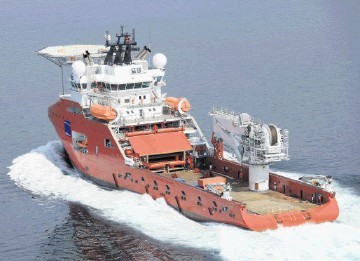
Following a number of high-grade additions to its fleet of offshore support vessels last year, DOF Subsea appears set on a course to challenge its first division subsea contracting peers.
During Q3 last year alone the company, a unit of Norwegian group DOF ASA, took delivery of the diving vessel Skandi Singapore and the construction ship Skandi Skansen. Also, the upgrading of the Skandi Niteroi was approved.
Earlier in the year, the company took ownership of the X-bow multi-purpose Skandi Constructor, originally named Sarah and built for now defunct Aberdeen company Marine Subsea.
Also during Q3, the company secured several new contracts including the Goliat FPSO marine installation contract; a four-year charter for the Niteroi with Petrobras and work was won in the Far East for the brand new Singapore and Hercules.
John Baxter, executive VP – business acquisition at DOF Subsea, told Energy at a briefing in Bergen: “Overall there are 73 ships in the (DOF) fleet and we believe we have among the highest contract coverage in the industry. Of that, roughly one third is subsea construction-focused.
“The fleet has increased by three ships and 47 ROVs since I joined the company (March 2011).
“However, in terms of size, DOF Subsea is not yet a tier-1 player like Saipem, Technip or Subsea 7.
“But that’s OK,” said Baxter who, given his role, wants to see the company join the premier tier.
“While our head office is in Bergen and we have a fairly large organisation running from the UK, one of our largest and fastest developing businesses, Asia-Pacific, is based in Perth, Western Australia.
“We’re bigger than Subsea 7 down there. Brazil is also a primary area and we’ve been very successful getting in early with Petrobras and with other operators like Chevron and Shell. We already have some 240 employees working out of the Brazil office.
“We can’t grow fast enough to keep up with the opportunities that are on the table for us in Perth, in Brazil and (for that matter) also in the North Sea. We’ve started in the US Gulf of Mexico and now have a ship operating constantly off Angola.”
Baxter said DOF Subsea is under pressure to grow rapidly.
“The message we’re getting is that, because of the current heat in the market, they (majors like Statoil) are strategically packaging projects together into larger and larger bundles. This means you must come up with a bigger service offering . . . in other words migrate to tier-1.
“That also goes without saying from the smaller operators where, although their field development might be relatively small, particularly in the UK sector, they don’t have the resources in-house to split a project into segments. That means you need to offer a suite of services if you are to engage with them in the first place.”
According to Baxter, vessels such as the newly commissioned Skansen have a natural market advantage as DOF “has not compromised” on the selection of the equipment aboard the new tonnage, not least the cranes and integrated twin-ROV suite.
Last year saw DOF Subsea execute the subsea decommissioning side of the Hess-operated Ivanhoe/Rob Roy fields in the UK North Sea and Baxter said he wanted to secure more business like this.
“We see decommissioning becoming a very interesting component of the business. It’s less technically challenging . . . a great opportunity for us to grow into what is becoming an increasingly important market.”
Turning to subsea intervention and singling out the Skandi Constructor, Baxter said this vessel has armed DOF with the fire-power to break into the well intervention market.
“We see a growing opportunity for well intervention,” he said. “We don’t intend to turn our company into a well intervention specialist, though we have been looking for a partner to offer this vessel to that market.
“Because of her X-bow, she’s an extremely good seakeeping ship . . . a very good platform for us as a construction vessel.”
Baxter added that he felt that vessel-based well intervention had yet to mature as a market, largely because of operator attitudes.
“A lot of them have an attitude towards subsea wells that, if it ain’t broke don’t fix it. Statoil is leading the way in the North Sea and they’re going out now for a frame agreement for probably for another two vessels . . . from 2014 for five to eight years, 365 days a year.”
Looking ahead, Baxter said DOF will take delivery of the Skandi Bergen in May. This is a niche vessel that is expected to be a good construction platform.
And even further ahead?
“We have so many different avenues to pursue in terms of where our vessels could operate, it’s hard to keep abreast of these opportunities.”